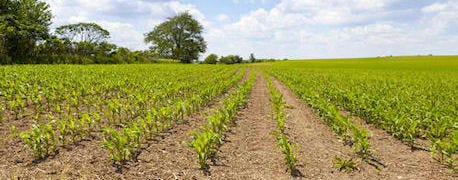June 3, 2014

Like most anything, double-cropping – or harvesting two crops from one field in the same year – has benefits and risks, and according to a new report completed by the USDA Economic Research Service, it's a practice that requires a second look to determine the merits of expanding its use.
In the report, Multi-Cropping Practices: Recent Trends in Double-Cropping, authors Allison Borchers, Elizabeth Truex-Powell, Steven Wallander and Cynthia Nickerson say higher commodity prices in the past few years have contributed to a resurgence in farmers looking for ways to maximize returns on the same amount of land.

Are two crops better than one? In some situations, maybe, but there are a lot of factors to consider before jumping into a double cropping system.
One way to expand production is by expanding cropland acres. However, cropland expansion is not without negative environmental consequences, the authors say. A recent ERS study found that about one-third of the expansion in harvested corn crop acreage represented shifts from hay production, Conservation Reserve Program enrollment, or grazing land use – all of which provide important environmental benefits, such as wildlife habitat and carbon reduction.
Related: Buy Land, They're Not Making Any More of It
Another way to expand production and potentially increase the economic returns to farming is to intensify the use of existing cropland, as with double cropping, which may substitute for expanding cropland acreage and may have fewer negative environmental consequences.
To examine the issue, study authors developed a baseline analysis of U.S. double-cropping patterns from 1999 to 2012 and briefly explored the role that farm programs may have in farmers' double-cropping decisions.
The study is intended to support future discussion on the factors influencing its use and on the merits of expanding its use.
~~~PAGE_BREAK_HERE~~~
Study finds small expansion
From 1999 to 2012, double cropping occurred on only about 2% of total U.S. cropland in most years, suggesting that relatively few farmers are choosing to adopt this practice. In comparison, from 2006 to 2011, an average of 1% to 2% of cropland acres were reported to be cover cropped, and 11% to 26% of planted acres for selected crops were grazed following harvest.
Additional findings from the study include:
The Southeast and Midwest contained the greatest total double-cropped land. The Southeast had about one-third of total U.S. double-cropped acreage, and the Midwest had slightly more than one-fifth. The Pacific Northwest contained the least double-cropped acreage, partly attributed to factors such as climate.
Viewed as shares of each region's total cropland, double cropping was most common in the Northeast, Southeast, and Southwest regions. The Northeast had the highest share (with nearly 10% of its cropland double cropped, on average), while the Northern Plains had the lowest share (with less than 0.5% double cropped, on average). The large Northeast acreage share suggests that the constraints short growing seasons pose to double cropping can be overcome with alternative crop combinations, production practices, or the use of new technologies, such as hybrid seeds, the report found.
Changing commodity prices. Over time, total double-cropped acreage tracked trends in soybean, winter wheat, and corn prices. When commodity prices were increasing or were relatively high at the time of planting decisions, the total double-cropped acreage also increased.
~~~PAGE_BREAK_HERE~~~
Slightly more than half of double-cropped acreage included soybeans. Nationally, an average of 53% of total double-cropped acres were double cropped with soybeans. Within the Southeast, soybeans represented a much larger share of double-cropped acreage than in other regions.
Crop insurance restrictions—including higher premiums tied to double cropping in some locations, or difficulty obtaining insurance for second crops—may discourage farmers from double cropping. However, if the market or environmental incentives for double cropping change, the crop insurance program has sufficient flexibility to avoid becoming a long-run constraint on double cropping.
Conclusions
Although double cropping may introduce negative environmental consequences of its own, researchers say double cropping has the potential to limit the environmental consequences associated with cropland expansion, such as increased soil erosion and loss of wildlife habitat or carbon sinks as U.S. farmers increase production to meet growing global demand.
Despite the fact that at least some farmers in every region of the country find double cropping profitable, the majority of cropland acres are not double cropped, the authors reiterate.
Future research, they say, may illuminate the barriers to double cropping, further explore the impact of Federal programs and policies on double-cropping decisions, and continue to examine the merits of expanding its use.
Source: USDA
You May Also Like




